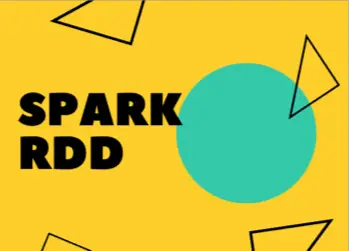Spark RDD is short for Apache Spark Resilient Distributed Dataset. A Spark Resilient Distributed Dataset is often shortened to simply Spark RDD. RDDs are a foundational component of the Apache Spark large scale data processing framework.
Table of Contents
- What is a Spark RDD?
- How are Spark RDDs created?
- Why Spark RDD?
- When to use Spark RDDs?
- What is the difference between a Spark RDD and a Spark Dataframe?
- What’s the difference between a Spark Dataframe and a Spark Dataset?
- Spark RDD Further Resources

What is a Spark RDD?
Spark RDDs are an immutable, fault-tolerant, and possibly distributed collection of data elements. RDDs may be operated on in parallel across a cluster of computer nodes. To operate in parallel, RDDs are divided into logical partitions. Partitions are computed on different nodes of the cluster through Spark Transformation APIs.
Spark RDDs may be Pyspark RDD or JVM based RDD.
RDDs support two types of operations: transformations, which create a new dataset from an existing one, and actions, which return a value by performing a computation on the RDD.
How are Spark RDDs created?
Spark RDDs are created through the use of Spark Transformation functions. Transformation functions create new RDDs from a variety of sources; e.g. textFile function from a local filesystem, Amazon S3 or Hadoop’s HDFS. Transformation functions may also be used to create new RDDs from previously created RDDs. For example, an RDD of all the customers from only North America could be constructed from an RDD of all customers throughout the world.
In addition to loading text files from file systems, RDDs may be created from external storage systems such as JDBC databases such as mySQL, HBase, Hive, Casandra or any data source compatible with Hadoop Input Format.
RDDs are also created and manipulated when using Spark modules such as Spark Streaming and Spark MLlib.
Why Spark RDD?
Spark makes use of data abstraction through RDDs to achieve faster and more efficient performance than Hadoop’s MapReduce.
RDDs support in-memory processing. Accessing data from memory is 10 to 100 times faster than accessing data from a network or disk. Data access from disk often occurs in Hadoop’s MapReduce-based processing.
In addition to performance gains, working through an abstraction layer provides a convenient and consistent way for developers and engineers to work with a variety of data sets.
When to use Spark RDDs?
RDDs are utilized to perform computations on an RDD dataset through Spark Actions such as a count or reduce when answering questions such as “how many times did xyz happen?” or “how many times did xyz happen by location?”
Often, RDDs are transformed into new RDDs in order to better prepare datasets for future processing downstream in the processing pipeline. To reuse a previous example, let’s say you want to examine North America customer data and you have an RDD of all worldwide customers in memory. It could be beneficial from a performance perspective to create a new RDD for North America only customers instead of using the much larger RDD of all worldwide customers.
Depending on the Spark operating environment and RDD size, RDDs should be cached (via cache function) or persisted to disk when there is an expectation for the RDD to be utilized more than once.
What is the difference between a Spark RDD and a Spark Dataframe?
Spark RDD (Resilient Distributed Datasets) and Spark DataFrames are both data structures in Apache Spark, but they have some differences.
RDD is the fundamental data structure in Spark, and it represents an immutable, distributed collection of objects. RDDs are fault-tolerant and can be cached in memory for faster processing. RDDs are suitable for low-level transformation and actions on data.
DataFrames, on the other hand, are a higher-level abstraction that provides a schema-based view of data. DataFrames are built on top of RDDs and allow for more efficient processing of structured data. They support SQL-like operations, such as filtering, aggregation, and joining, and can be used with various data sources like CSV, JSON, and Parquet.
In summary, RDDs are more suitable for low-level transformations and actions on data, while DataFrames are better for working with structured data and performing SQL-like operations.
What’s the difference between a Spark Dataframe and a Spark Dataset?
Spark DataFrame and Spark Dataset are both higher-level abstractions of Spark RDDs, but they have some differences.
Spark DataFrame is a distributed collection of data organized into named columns. It is an immutable distributed collection of data that is designed to support structured and semi-structured data. Spark DataFrame provides a higher-level API than RDDs and allows for efficient querying and filtering of data using SQL-like syntax.
Spark Dataset is a distributed collection of data that provides the benefits of both RDDs and DataFrames. It is a type-safe API that allows for compile-time type checking and provides the ability to use lambda functions for complex data processing. Spark Dataset is an extension of Spark DataFrame API and provides the benefits of both RDD and DataFrame APIs.
The main difference between Spark DataFrame and Spark Dataset is that Spark Dataset is a strongly typed API, which means that it provides compile-time type checking and allows for better optimization of code at runtime. On the other hand, Spark DataFrame is a weakly typed API that provides runtime type checking and is suitable for working with structured and semi-structured data.
In summary, Spark DataFrame is a higher-level abstraction of Spark RDD that provides a SQL-like syntax for querying and filtering data, while Spark Dataset is a strongly typed API that provides better optimization of code at runtimeReal-Time Data
Spark RDD Further Resources
Scala Spark RDD Transformation API examples
Python RDD Transformation API examples
Spark Tutorials Landing page

